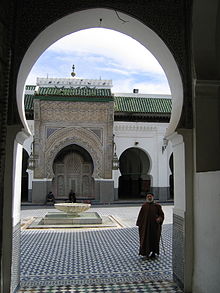Qarawīyīn Mosque

The Qarawīyīn Mosque ( Arabic جامع القرويين Jāmiʿ al-Qarawīyīn , DMG Ǧāmiʿ al-Qarawiyyīn ) in the middle of the medina of Fès -el-Bali is the historically and politically most important mosque in Morocco .
history
The Qarawīyīn Mosque was founded in 857 (or 859) by the wealthy merchant's daughter Fatima al-Fihri , whose father emigrated from Qairawān to Fez at the beginning of the 9th century . Because of the steadily increasing economic, cultural and religious-political importance of Fès, the rather small original building was repeatedly expanded and richer in equipment in the following centuries. The mosque building got its present form mainly under the Almoravids .
architecture
The entire mosque is made of brick and plastered white. All arches are designed as horseshoe arches. The many gable roofs direct the rainwater into aqueduct-like collecting channels. The green glazed roof tiles do not reflect the original condition, because glazing techniques were only used in the Islamic West in the 11th / 12th centuries. Century known (see minaret of the Koutoubia Mosque in Marrakech ).

patio
Today's main entrance allows a view of a small part of the inner courtyard ( ṣaḥn ) with its central three-part fountain for the ablutions prescribed before prayer. The entire courtyard area is covered with blue and white glazed tiles. Under the Saadians in the 16th century, the courtyard was enriched by two side pavilions equipped with additional fountain shells, which, with their slender groups of columns, are reminiscent of two similar buildings in the Alhambra 's lion courtyard ; Here, however, the upper area - in typical Moroccan tradition - is designed with geometric carvings made of cedar wood.
Prayer room
The supports of mainly of 21 naves and 10 transepts existing prayer room of Qarawiyin Mosque are - in contrast to the ancient columns spoils the great forerunner in Qairawan and Córdoba - brick masonry and then whitewashed pillars on which decor loose horseshoe arches rest. Only the vaulted ceilings of the slightly raised central nave yokes, which taper towards the mihrab niche, were given a rich muqarnas stucco decoration in the first half of the 12th century .
In the past, the mosque was accessible through gates from three sides and - with a floor area of approx. 85 × 70 meters - offered a maximum of around 20,000 believers for prayer, but now this number is far from being reached even during Friday prayers.
minaret
That under the Spanish Umayyad - Caliph Abd ar-Rahman III. Erected from stone in the middle of the 10th century and - unlike in Kairouan - the largely undivided minaret (see web link) is one of the earliest in the entire Maghreb . It consists of a décor-free and undivided tower shaft, which is only broken up in the upper part by open double arches. Above this is a slightly cantilevered platform framed by crenellated walls. A ribbed dome forms the architectural end of the minaret, which is only around 30 meters high. A similar minaret has been found at the Mosque of the Andalusians ( Jāmiʿ al-Andalusīyīn /جامع الأندلسيين / Ǧāmiʿ al-Andalusiyyīn ), not far from the Qarawīyīn.
Furnishing
The minbar of the Qarawīyīn mosque dates from the Almoravid period (1135). A short time later, the central nave was equipped with five bronze chandeliers, the core of which consisted of church bells captured in Spain.
meaning
The Qarawīyīn mosque is the oldest surviving mosque in Morocco, along with the Andalusian mosque that was built around the same time in Fez. The affiliated university al-Qarawīyīn is probably the oldest university in the Islamic world. The extensive manuscript library - Maktabat al-Qarawīyīn - has been the most important collection point for Islamic manuscripts in the country for centuries.
literature
- Markus Hattstein and Peter Delius (eds.): Islam - Art and Architecture. Könemann-Verlag, Cologne 2000, p. 256f and p. 310ff ISBN 3-89508-846-3
- Henri Stierlin: Islam - Early Buildings from Baghdad to Cordoba. Taschen-Verlag, Cologne 1996, pp. 188f ISBN 3-8228-8728-5
- Martin Frishman, Hasan-Uddin Khan (ed.): The mosques of the world. Campus-Verlag, Frankfurt / New York 1995, p. 111 ISBN 3-89340-024-9
- Arnold Betten: Morocco. Antiquity, Berber Traditions and Islam - History, Art and Culture in the Maghreb. DuMont, Ostfildern 2009, p. 176f ISBN 978-3-7701-3935-4
- Ingeborg Lehmann, Rita Henss: Morocco . Baedeker, Ostfildern 2010, p. 258f ISBN 978-3-8297-1251-4
Web links
Coordinates: 34 ° 3 '53.6 " N , 4 ° 58' 24.1" W.